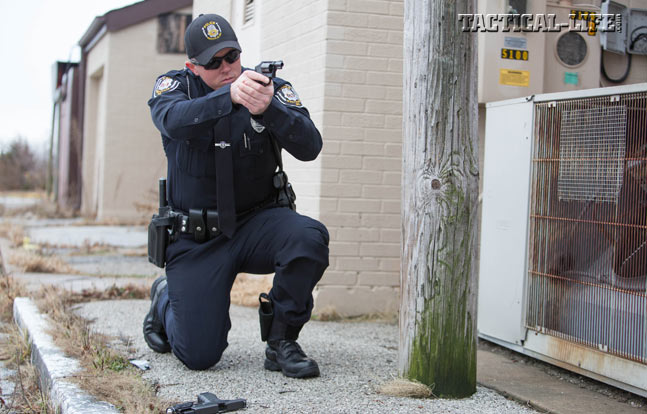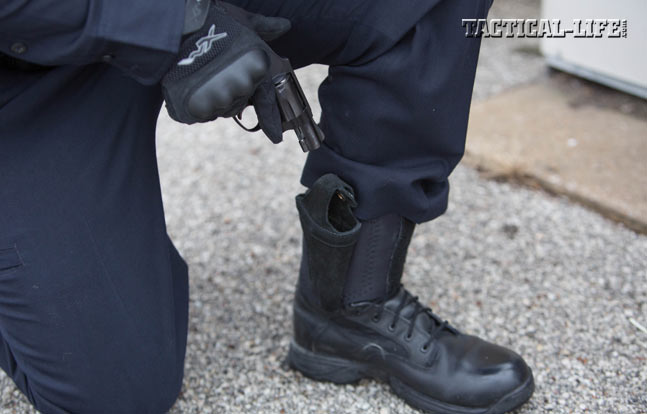Back in ’81, a small-town chief had to go see some local gang-bangers who had threatened the life of a prominent professional man in the community. Short-handed, able to muster only two part-time officers to assist, the chief “deputized” the complainant, whom he knew to be good with a gun. Within moments, the confrontation turned into a gunfight in an alley. The chief was wounded, and one of his part-time cops was down with a bullet wound. The deputized citizen had emptied both a shotgun and a revolver. One of the wounded gang members aimed at the citizen and sneered, “I got you now.”
The citizen whipped out his backup handgun, a Colt .38 revolver, and pumped a bullet into the gang member’s chest. At virtually the same moment, the downed officer fired from prone and scored a headshot on the gunman with his .45. Those were the last of some 30 shots fired; three gang members were dying or dead, two of them fatally wounded by the armed citizen, who survived along with the officers.
I neglected to mention that the year was 1881, the alley was near the OK Corral in Tombstone, Arizona, and the man who saved his life with a Colt Lightning .38 after dumping his borrowed shotgun and his empty Colt Peacemaker .45 was one John “Doc” Holliday. Consider it Case One.
Advertisement — Continue Reading Below

Modern Times
Armed citizen or cop or soldier, the second gun has always been a potential lifesaver. I recently debriefed the hero in Case Two, who had been seriously wounded in combat with the Taliban and had been dragged to the safety of a building, given first aid and left to await MED-EVAC as his rescuers returned to the raging firefight outside. Suddenly, a Taliban fighter entered the no-longer-safe haven with an AK-47. Unable to reach his M4, the wounded soldier snatched his Beretta M9 from its Safariland thigh holster and emptied it into the enemy combatant, killing him and saving his own life as well as that of another wounded soldier.
Yes, when a soldier or cop is unable to reach their long gun, as in Case Two, or has emptied it, as in Case One, the primary handgun becomes the “backup” by default. This was what happened in Case Three, which I recently worked as an expert witness for the involved deputy and his department. Three deputies had responded to a report of a man with a gun in the street terrorizing passersby. Understandably, the deputy in question slung on his department-issued Colt 5.56mm patrol rifle when he exited the vehicle. The officers cornered the suspect, by now with no weapon in hand, so no one fired. However, he resisted physically, and a Taser was successfully employed. When the “five-second ride” was over, the subject sprang to his feet and lunged for the officer with the rifle, trying to grab it and shoot the cops.
Advertisement — Continue Reading Below
The deputy with the rifle did exactly as he was trained. He clamped the rifle to his chest with his left arm, and with his right hand drew his Sig P229 and triggered a .40-caliber double-tap into the attacker’s chest from a retention position. The man collapsed immediately and died. With one of the other two officers on scene holding the Taser instead of a gun, and the other not in a position to shoot without harming brother officers, the deputy under attack was the only one who could stop the attack before the extremely violent subject gained control of the weapon. His immediate recourse to his second weapon saved the lives of the other two deputies as well as his own.

Secondary Handguns
The OK Corral shooting was the most famous and most studied shootout of the 19th century, so let’s end with what might be the most notorious and most thoroughly analyzed gunfight of the 20th century. Case Four occurred on April 11, 1986, in Dade County, Florida. It left two perpetrators and two FBI agents dead, three agents permanently injured by gunfire, and two more agents wounded.
Advertisement — Continue Reading Below
In the course of that high-volume firefight, two agents, John Hanlon and Ron Risner, at various points returned fire with their backup Chief’s Special snubbies. Hanlon had lost his six-shot service revolver in the car crash that preceded the shooting, and Risner initially went to his backup .38 when his 9mm semi-auto ran dry. Supervisory Special Agent Gordon McNeill wounded one perp before his .357 revolver ran dry, and he was unable to reload due to a hand injury. With no backup gun, he was unable to return fire before his antagonist shot him again and crippled him for life with a .223 round. Special Agent Jerry Dove, his S&W 9mm having both run dry and been ruined by a hit from the .223, was helpless to return fire when he was confronted at close-range and executed by the vicious rifleman; he too had no backup handgun. The bloody battle came to an end when Agent Edmundo Mireles, one arm rendered useless by a .223 wound, emptied his Remington 870 shotgun one-handed, and then took recourse to his “backup,” the S&W Model 686 that was his primary service revolver. With that gun, he closed on the two gunmen and killed them both, coolly and carefully firing one-hand-only.
Another lesson from that fight: Bad guys use backup guns, too. At one point, cop-killer Michael Platt had emptied his stolen .223 and fell back to a .357 revolver to fire at the agents. He dumped that, reloaded the rifle and went on the attack again. When a wound inflicted by Agent Risner caused him to drop the rifle, Platt grabbed another .357 from his wounded partner in crime, William Matix, and launched three final shots toward the agents before Mireles killed him and his cohort.

Saving Lives
Advertisement — Continue Reading Below
There are any number of situations in which a backup gun can save the lives of police officers—and as many situations in which the officer without one may become a helpless murder victim. Most agencies authorize and encourage the carrying of a second, concealed handgun on duty. At least three state police agencies issue second weapons and require the troopers to carry them in uniform along with the duty sidearm. Across three centuries, the rationale of the backup gun has been well and truly documented.



































